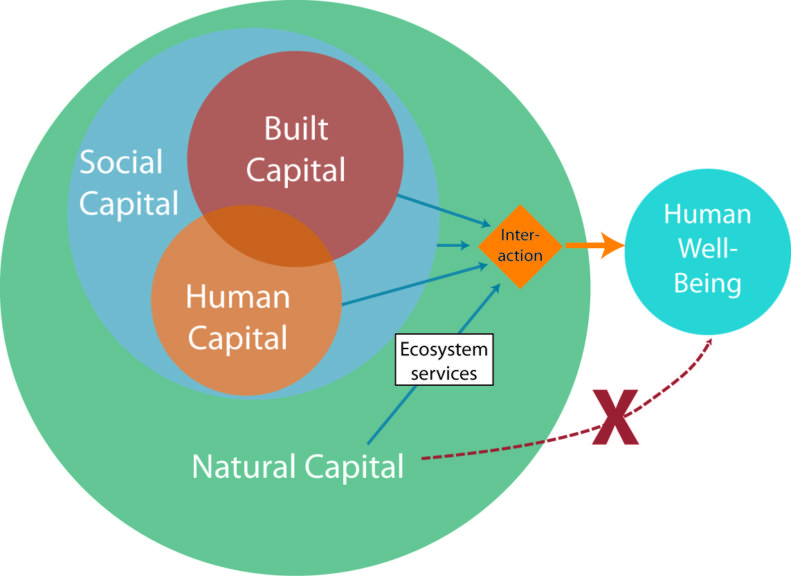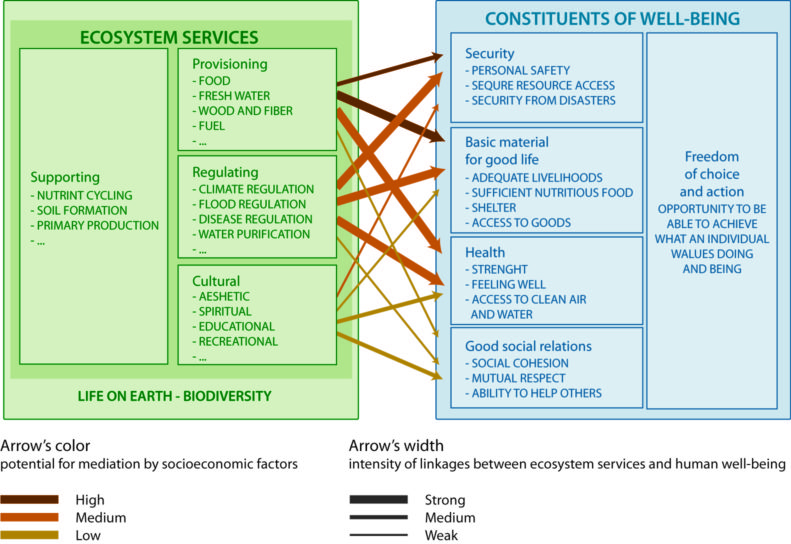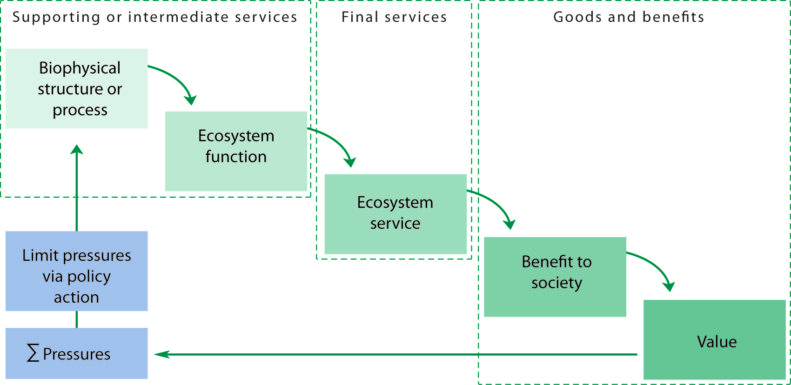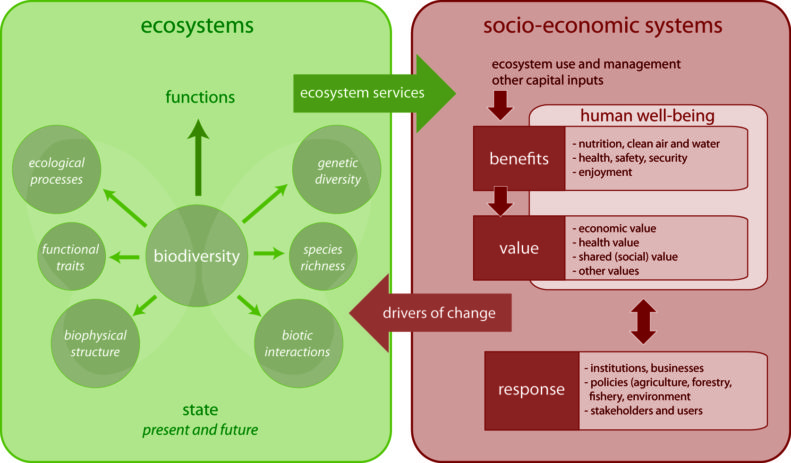1. Ecosystem service concept and classification systems
1.1. Ecosystem service concept
Ecosystems have potential to supply a range of services that are of fundamental importance to human well-being, health, livelihoods, and survival (Costanza et al., 1997; Millennium Ecosystem Assessment (MEA), 2005; TEEB Synthesis, 2010). Different ways of defining ecosystem service have been developed so far – they can be described as the benefits that people obtain from ecosystems (MEA, 2005) or as the direct and indirect contributions of ecosystems to human well-being (TEEB, 2010). More recent publications define the ecosystem services (ES) as contributions of ecosystem structure and function (in combination with other inputs) to human well-being (Burkhard et al., 2012; Burkhard B. & Maes J. Eds., 2017).
Ecosystem cannot provide any benefits to people without the presence of people (human capital), their communities (social capital), and their built environment (built capital). Thus ecosystem services should be perceived as a contribution of the natural capital to human well-being, which forms only by interaction with human, social and built capital (Fig. 1.1.).

Figure 1.1. Interactions between built, social, human and natural capital required to produce human well-being (Source: Costanza et al., 2014).
Ecosystem services can be perceived also as an interface between people and nature, which is illustrated by so called ‘cascade model’ (Haines-Young and Potschin, 2010; Potschin and Haines-Young, 2016; Burkhard and Maes (Eds.), 2017). This model describes the pathway of causal interrelations between ecosystem at one end and the human well-being at another (Fig. 1.2). The ecosystem within this model is characterized by its biophysical structures and processes. The biophysical structure, in a more simple way, can be labelled as a habitat type (e.g. woodland, wetland, grassland etc.), while processesrefers to dynamics and interactions forming the ecological system (e.g. primary production). The ecosystem functions, in the context of the cascade model, are understood as the characteristics or behaviours of the ecosystem that underpins its capacity to deliver an ecosystem service (e.g. ability of the woodland or grassland to generate a standing stock of biomass). Those elements and features, which are behind the ecosystem capacity to deliver services, are sometimes called ‘supporting’ or ‘intermediate’ services, while the ‘final’ ecosystem service is what we actually can harvest (e.g. hey, timber) or gain from ecosystem (e.g. flood protection, beautiful landscape etc.). The ‘final’ services directly contribute to human well-being through the benefits that they support (e.g. health and safety). People are used to assign values to the benefits, therefore they are also referred as ‘goods’ and ‘products’. The value can be expressed in many different ways – using monetary as well as moral, aesthetic or other qualitative criteria.
The capacity of the ecosystem to supply services for human well-being directly depends on the ecosystem condition (its structure and processes). While increasing the pressure on ecosystem or by changing the land use type (and thus fundamentally impacting or destroying the previous ecosystem), people influence the ecosystem service supply or trade-offs between different services. For example, by draining a wetland people can gain arable land and thus valuable food products, but at the same time lose such services as flood protection, natural habitats and species diversity as well as possibilities for nature tourism. In counting together all the benefits (in monetary or other valuation system), the value of wetland most probably would be much higher that the value of arable land.
Biodiversity has essential role in supply of the ecosystem services although this interrelation not always is so straightforward. Mostly it is associated with so called ‘supporting or intermediate services’, although few studies demonstrated a direct linear relation between species diversity and ecosystem productivity, biomass production, nutrient cycling etc. (Haines-Young and Potschin, 2010). For example there is experimental evidence that maintaining high levels of plant species diversity increases grassland productivity (e.g. Fagan et al., 2008). The productivity is an ecosystem function that underpins a range of ecosystem services (e.g. biomass production, soil formation and erosion control). However, it is not only the species richness, which supports the ecosystem service supply – there are also other ecosystem properties, which plays significant role, e.g. presence of particular species or species groups with particular features, that have certain function in ecosystem or its performance. For example, the ability of vegetation to store nutrients (used in establishing buffer stripes along water bodies) might depend on presence of species with the particular feature and their abundance in relation to the level of nutrients in the system. Such features of species are called functional traits. There is an agreement among researchers that functional diversity, formed by type, range and relative abundance of functional traits in a community, can have important consequence for ecosystem processes (De Bello et al., 2008). Ecosystems, where functional groups (i.e. groups of species with similar functions) are formed by ecologically similar species with different reactions on environmental pressures, are more resistant to adverse effects and thus can continue to supply services essential for human well-being.
The interrelation between biodiversity, ecosystem and socio-economic system via flows of ecosystem services and drivers of change is reflected also within the conceptual framework for EU and national ecosystem assessment developed by MAES initiative under Action 5 of the EU Biodiversity strategy (Maes et al., 2016) (Fig. 1.3).
Based on changes of the values or preferences/demand for the benefits provided by ecosystem, people make judgements about the kinds of interventions in the ecosystem either by protecting ecosystem or enhancing the supply of ecosystem service. Therefore knowledge on ecosystem service supply and their links to biodiversity as well as limits of ecological functioning and how external pressures may impact on ecological structures and processes is crucial when making decisions on land use or development projects, which are impacting ecosystem condition.
1.2. History of the concept development and its role in policy making
The ecosystem service concept is relatively new. It appeared on research agenda during the last decades of the 20thcentury, when the first publication on this topic were issued. An important milestone in ecosystem service evaluation was de Groot’s publication “Functions of Nature” (1992), followed by Costanza et al. (1997) and Daily (1997), who further developed and promoted the concept in a global context. However, the idea was brought up already in 1970 within the Study of Critical Environmental Problems (SCEP), when a concept of ‘environmental services’ was first mentioned.
The concept gained recognition among policy makers when the United Nations published the “Millennium Ecosystem Assessment” (MA) in 2005. The work on the MA started in 2001 involving over 1300 international experts. The study provided a comprehensive, global assessment of human impacts on ecosystems and their services, analysis of ecosystems condition and trend as well as possible solutions for restoration, maintenances and sustainable use. The key finding of the MA was that currently 60 per cent of the ecosystem services evaluated are being degraded or used unsustainably.
The following international initiative – The Economics of Ecosystems and Biodiversity – TEEB, carried out in 2007 – 2010, brought in the economic perspective of the ecosystem services in the policy debate. TEEB aimed to highlight the economic value of biodiversity as well as the costs arising from biodiversity loss and ecosystem degradation. TEEB was initiated by the European Commission and the German Federal Ministry for the Environment, Nature Conservation, Building and Nuclear Safety, responding to proposal of environment ministers from the G8+5 countries meeting in Potsdam, Germany in March 2007. The study was performed by wide network of international and national organisations involving expertise in different fields of science, economics and policy. The findings of TEEB were published in several report including: TEEB Ecological and Economic Foundations; TEEB in national and International Policy making; TEEB in Local and Regional Policy; TEEB in Business and Enterprise; as well as the TEEB Synthesis Report, which summarise the main findings and recommendations. The international TEEB initiative has been followed up by several national TEEB studies in order to demonstrate the value of ecosystems for national policy makers.
Ecosystem services mapping and assessment have become high on the agenda of all EU Member States after the adoption of the EU Biodiversity Strategy to 2020 in 2011. The strategy aims at halting the loss of biodiversity and the degradation of ecosystem services in the EU by 2020, and restoring them in so far as feasible. In line with its Action 5 “Improve knowledge of ecosystems and their services in the EU”, mapping and assessment of the ecosystems and their services in national territories would have to be carried out by 2014 and the economic values of ES have to be assessed by 2020. In the context of the Strategy ‘mapping’ stands for the spatial delineation of ecosystem as well as quantification of their condition and the service supply, while ‘assessment’ refers to the translation of this scientific evidence into information that is understandable for policy and decision making (Maes et al., 2016).
To support implementation of the Action 5 of the EU Biodiversity Strategy 2020 European Commission has established a working group on ‘Mapping and Assessment of Ecosystems and their Services’ – MAES), which involves experts of the European Commission, the member states and the research community. It provides analytical framework (consisting of four different steps: 10 mapping of the ecosystems; 2) assessment of the ecosystem condition; 3) assessing of ecosystem services; and 4) and integrated assessment) as well as guidance for implementation of the Action 5 within EU and in the Member States. Several Member States have made already good progress in this field and performed their national MAES process, while many countries including the Baltic States are just at the initial stage for mapping of ecosystems and their services at national level. The Biodiversity Information System for Europe – BISE holds the information on completed as well as ongoing initiatives at EU and national level with regard to mapping and assessment of ecosystems and services they supply.
At the same time several international co-operation platforms are established, linking researchers, research organisations and national authorities involved in the field of ecosystem service assessment. For example, Ecosystem Service Partnership – ESP, launched in 2008 by the Gund Institute for Ecological Economics (University of Vermont, USA) is formed by institutional and individual members from all over the world. ESP aims to enhance communication and cooperation in the field of ecosystem services by organising international conferences, trainings, data and experience exchange and building a strong network of experts.
The Intergovernmental Science-Policy Platform on Biodiversity and Ecosystem Services – IPBES was established in 2012, aiming at strengthening the science-policy interface for biodiversity and ecosystem services as well as for the conservation and sustainable use of biodiversity, long-term human well-being and sustainable development. It is supported by four United Nations entities: UNEP, UNESCO, FAO and UNDP and administered by UNEP. One of the main directions in the work programme of the IPBES is assessment of biodiversity and ecosystem services at regional and global level.
1.3. Classification of ecosystem services
Categorisation of ecosystem service is a precondition for any attempt to measure, map or value them and to communicate the findings in a transparent way (Burkhard and Maes (Eds.), 2017). A number of different typologies and approaches to classify ecosystem services are developed using different criteria, e.g. spatial character and scale; service flow (see the cascade model described before); service beneficiary (private vs public); type of benefit (‘use’ vs ‘non-use’), or whether the use of a service by one individual or group affects the use by others (‘rival’ vs ‘non-rival’).
One of the perspectives how to approach ecosystem services classification can be raising awareness in society about the different benefits what humans gain from the ecosystem. This approach was also in foundation of the MA classification system, which was proposing four main ecosystem categories:
- Provisioning services – food, materials and energy, which are directly used by people;
- Regulating services – those that cover the way ecosystems regulate other environmental media or processes;
- Cultural services – those related to the cultural or spiritual needs of people.
- Supporting services – ecosystem processes and functions that underpin other three types of services.
Examples of services under each of the four categories and their relationship to different components of human well-being are presented in the Fig. 1.4.

Figure 1.4. The links between ecosystem services and human well-being as described by MA classification system (Source: MA, 2005).
The TEEB study applies similar classification approach as proposed by MA, distinguishing ‘provisioning’, ‘regulating’ and ‘cultural’ services, while the forth category is labelled ‘habitat or supporting services’, which cover habitats for species and maintenance of genetic diversity.
In order to overcome a ‘translation’ problem between different classification systems, which are not always comparable due to different perspectives or definitions of the categories, the Common International Classification of Ecosystem Services–CICES was proposed in 2009 and later revised in 2013. It was originally developed as part of the work on The System of Environmental-Economic Accounting – SEEA, led by the United Nations Statistical Division (UNSD), aiming to collect internationally comparable statistical data on environment in relation to economy and thus creating a basis for ecosystem service accounting system.
The CICES is hierarchically organised – it applies the three major ‘sections’ of services – ‘provisioning’, ‘regulating’ and ‘cultural’, defined basically in the same way as in the MA and TEEB classification, and then splits them further into ‘divisions’, ‘groups’ and ‘classes’ (Fig. 1.5). The hierarchical structure allows users to go down to the most appropriate level of detail required by their application as well as combine results when making comparisons or more generalised reports. If refereeing to the ‘cascade model’ described above, this classification system is targeted to the ‘final services’ – the ‘end-products’ of nature from which goods and benefits are derived. CICES does not include the supporting services – ecosystem structure, processes and functions, from which society is not benefiting directly, but throw the flow of final service. Though, it does not mean the supporting services are less important, but such narrowing down of the assessment scope is essential to avoid the double accounting when valuing the ecosystem services – i.e. assessing the importance of a nature component more than once because it is embedded in, or underpins, a range of other service outputs (Burkhard and Maes (Eds.), 2017).

Figure 1.5. The hierarchical structure of CICES, illustrated with reference to a provisioning service (cultivated plants- cereals) (Source: MA, 2005).
The CICES is applied in various international project as well as ecosystem service assessment at national scale. It also forms a part of the ecosystem service assessment and mapping framework, develop by the MAES working group to support implementation of the EU Biodiversity Strategy 2020. CICES version 4.3 was applied until 2017, however a need for its further improvement has been realised (e.g. better representation of abiotic ecosystem services as well as integration with typologies for underlying ecosystem functions). Therefore after extensive period of consultation and peer review the new ‘CICES version 5.1’ was developed and now available at the CICES website, including also a guidance document. The new version is consistent with but extends CICES version 4.3.
Another, more complex approach is applied by IPBES, which provides an overarching typology of values related to nature and quality of life, intended to guide the assessment of values within IPBES activities. This typology presents a renege of values, arising from very different worldviews and is organized around the three broad categories:
- intrinsic value of nature– including individual organisms, biophysical assemblages, biophysical processes and biodiversity;
- nature´s benefits to people, which includes:
- biosphere‘s ability to enable human endeavour (i.e. embodied energy; human appropriation of net primary production; total material consumption; life cycles, carbon and water footprint; land cover flows etc.);
- nature‘s ability to supply benefits (i.e. habitats for fisheries, contribution of soil biodiversity to sustenance of long-term yields, biodiversity for future options);
- nature‘s gifts, goods and services (i.e. regulating services: climate regulation, regulation of water flows, pollination, biological control etc.; provisioning services: food, medicine, timber, water, bioenergy etc.; cultural services: ecotourism, education, psychological benefits etc.);
- good quality of life– including security and livelihoods; sustainability and resilience; diversity and options; living well and in harmony with nature and Mother Earth; health and well-being; education and knowledge; identity and autonomy; good social relations; art and cultural heritage; spirituality and religions; governance and justice.
Nevertheless, taking into account the complexity of the issue, one comprehensive classification system, suitable for all assessment purposes, most probably would not be possible. The choice of the appropriate classification approach depends on the objective of the study or the decision making context. However, the comparability and transparency of the results of the various studies and approaches still remains a challenge.
Slides of the lecture “Ecosystem service concept and classification systems”
Suggested reading:
Burkhard, B., Kroll, F., Nedkov, S., Müller, F., 2012a. Mapping supply, demand and budgets of ecosystem services. Ecological Indicators 21: 17-29.
Burkhard, B., de Groot, R., Costanza, R., Seppelt, R., Jørgensen, S.E., Potschin, M., 2012b. Solutions for sustaining natural capital and ecosystem services. Ecological Indicators 21: 1–6.
Burkhard, B,, Maes, J. (Eds.) 2017. Mapping Ecosystem Services. Pensoft Publishers, Sofia, 374 pp. Available at: http://ab.pensoft.net/articles.php?id=12837
Costanza, R., D’Arge, R., de Groot, R.S., Farber, S., Grasso, M., Hannon, B., Limburg, K., Naeem, S., O’Neill, R.V., Paruelo, J., Raskin, R.G., Sutton, P., van den Belt, M., 1997. The value of world’s ecosystem services and natural capital. Nature 387: 253- 260.
Costanza, R., de Groot, R., Sutton, P., van der Ploeg, S., Anderson, S.J., Kubiszewski, I., Farber, S., Turner, R.K., 2014. Changes in the global value of ecosystem services. Global Environmental Change 26: 152–158.
De Bello, F., Lavorel, S., Díaz, S., Harrington, R., Bardgett, R., Berg, M., Cipriotti, P., Cornelissen, H., Feld, C. , Hering, C., Martins da Silva, P., Potts, S., Sandin, L., Sousa, J. S., Storkey, J., Wardle, D., 2008. Functional traits underlie the delivery of ecosystem services across different trophic levels. Deliverable of the Rubicode Project (download: www.rubicode.net/rubicode/outputs.html ).
De Groot, R.S., 1992. Functions of Nature: Evaluation of Nature in Environmental Planning, Management and Decision Making. Wolters-Noordhoff BV, Groningen.
Daily, G.C., 1997. Nature‘s Services Societal Dependence On Natural Ecosystems. Island Press, Washington D C.
European Union, 2014. Mapping and Assessment of Ecosystems and their Services. Indicators for ecosystem assessments under Action 5 of the EU Biodiversity Strategy to 2020. 2nd Report – Final, February 2014. pp.80
Fagan, K. C., Pywell, R. F., Bullock, J. M., Marrs, R. H., 2008. Do restored calcareous grasslands on former arable fields resemble ancient targets? The effect of time, methods and environment on outcomes . Journal of Applied Ecology, 45 (4), 1293 –303.
Fisher, B., Turner, R.K., Morling, P., 2009. Defining and classifying ecosystem services for decision making. Ecological Economics 68 (3): 643–653.
Haines-Young, R., Potschin M., 2010. The links between biodiversity, ecosystem services and human well-being. In: Raffaelli, D.G & C.L.J. Frid (eds.): Ecosystem Ecology: A New Synthesis. Cambridge University Press, British Ecological Society, pp. 110-139.
Haines-Young, R., Potschin, M., 2013. Common International Classification of Ecosystem Services (CICES): Consultation on Version 4, August-December 2012. EEA Framework Contract No EEA/IEA/09/003. Pieejams: http://cices.eu/
Maes, J., Teller, A., Erhard, M., 2014. Mapping and Assessment of Ecosystems and their Services. Indicators for ecosystem assessments under action 5 of the EU biodiversity strategy to 2020. Publications office of the European Union, Luxembourg.
Maes, J., Liquete, C., Teller, A., Erhard, M., Paracchini, M.L., Barredo, J.I., Grizzetti, B., Cardoso, A., Somma, F., Petersen, J., 2016. An indicator framework for assessing ecosystem services in support of the EU Biodiversity Strategy to 2020. Ecosystem Services, 17: 14–23.
Millennium Ecosystem Assessment, 2005. Ecosystems and Human Wellbeing: Synthesis. Island Press.Washington, DC, p. 137.
Potschin, M. Haines-Young, R., 2016. Defining and measuring ecosystem services. In: Potschin, M., Haines-Young, R., Fish, R. and Turner, R.K. (eds) Routledge Handbook of Ecosystem Services. Routledge, London and ä New York, pp 25-44.
Rodríguez, J.P., Jr. Beard, T.D., Bennett, E.M., Cumming, G.S., Cork, S., Agard, J., Dobson, A. P., Peterson, G.D., 2006. Trade-offs across space, time, and ecosystem services. Ecology and Society 11(1): 28. [online] URL: http://www.ecologyandsociety.org/vol11/iss1/art28/.
TEEB, 2009. TEEB – The Economics of Ecosystems and Biodiversity for National and International Policy Makers – Summary: Responnding to the value of nature, p. 40.
TEEB, 2010. The Economics of Ecosystems and Biodiversity: Mainstreaming the Economics of Nature: A synthesis of the approach, conclusions and recommendations of TEEB. p. 36.









